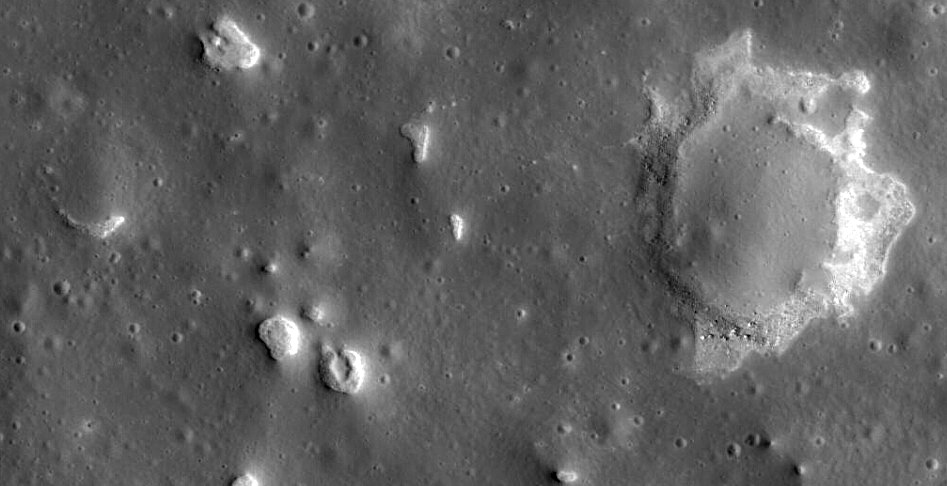Difference between revisions of "March 20, 2010"
| (4 intermediate revisions by the same user not shown) | |||
| Line 1: | Line 1: | ||
__NOTOC__ | __NOTOC__ | ||
=Another Ina?= | =Another Ina?= | ||
| + | <!-- Start of content --> | ||
<!-- ws:start:WikiTextHeadingRule:1:<h1> --> | <!-- ws:start:WikiTextHeadingRule:1:<h1> --> | ||
<!-- ws:start:WikiTextLocalImageRule:16:<img src="/file/view/LPOD-Mar20-10.jpg/128990257/LPOD-Mar20-10.jpg" alt="" title="" /> -->[[File:LPOD-Mar20-10.jpg|LPOD-Mar20-10.jpg]]<!-- ws:end:WikiTextLocalImageRule:16 --><br /> | <!-- ws:start:WikiTextLocalImageRule:16:<img src="/file/view/LPOD-Mar20-10.jpg/128990257/LPOD-Mar20-10.jpg" alt="" title="" /> -->[[File:LPOD-Mar20-10.jpg|LPOD-Mar20-10.jpg]]<!-- ws:end:WikiTextLocalImageRule:16 --><br /> | ||
<em>LROC Observation M104476560L from [http://wms.lroc.asu.edu/lroc#damoon LROC WMS Image Map] (illumination from the left)</em><br /> | <em>LROC Observation M104476560L from [http://wms.lroc.asu.edu/lroc#damoon LROC WMS Image Map] (illumination from the left)</em><br /> | ||
<br /> | <br /> | ||
| − | The peculiar depression [ | + | The peculiar depression [https://the-moon.us/wiki/Ina Ina] has a bizarre floor of [[February_3,_2010|rubbly hills and islands of smooth terrain]]. Sorting through the LRO images released on March 15 I found this image of part of the floor of Hyginus crater that looks similar. The largest roughly circular feature is 350-400 m wide, but it is not clear what the feature is. Smaller circular to irregular depressions are across the scene. The arcuate depression on the left looks like it continues as a circular feature covered by the darker material. But if Hyginus is like Ina, the dark smooth material is as old as maria outside Hyginus, suggesting that it is not a younger deposit. Thus, it seems that something is removing the terrain under the original mare surface. Like Ina, Hyginus is thought to be a volcanic collapse depression. Perhaps volcanic gases dissolve the regolith in volcanic craters causing this characteristic pattern. But what gas would do this? Comparison with the 43 year old Orbiter V [http://www.lpi.usra.edu/resources/lunarorbiter/frame/?5095 image] reveals no obvious changes so the process does not appear to be active on a human timescale.<br /> |
<br /> | <br /> | ||
<em>[mailto:tychocrater@yahoo.com Chuck Wood]</em><br /> | <em>[mailto:tychocrater@yahoo.com Chuck Wood]</em><br /> | ||
<br /> | <br /> | ||
<strong>Related Links</strong><br /> | <strong>Related Links</strong><br /> | ||
| − | Rükl plate [ | + | Rükl plate [https://the-moon.us/wiki/R%C3%BCkl_34 34]<br /> |
Note that Pete Schultz and colleagues included Hyginus as an Ina-like object in their 2006 [http://adsabs.harvard.edu/abs/2006Natur.444..184S paper].<br /> | Note that Pete Schultz and colleagues included Hyginus as an Ina-like object in their 2006 [http://adsabs.harvard.edu/abs/2006Natur.444..184S paper].<br /> | ||
<br /> | <br /> | ||
| + | <p><b>Yesterday's LPOD:</b> [[March 19, 2010|The Case of the Missing Rim]] </p> | ||
| + | <p><b>Tomorrow's LPOD:</b> [[March 21, 2010|How Thick Are Rays?]] </p> | ||
<hr /> | <hr /> | ||
| − | < | + | <table class="wiki_table"> |
| − | < | + | <tr> |
| − | ---- | + | <td> <!-- RemoveRevolverMaps --> |
| − | + | <!-- RemoveRevolverMaps --> | |
| − | + | </td> | |
| + | <!-- End of content --> | ||
| + | {{wiki/ArticleFooter}} | ||
Latest revision as of 17:51, 13 October 2018
Another Ina?

LROC Observation M104476560L from LROC WMS Image Map (illumination from the left)
The peculiar depression Ina has a bizarre floor of rubbly hills and islands of smooth terrain. Sorting through the LRO images released on March 15 I found this image of part of the floor of Hyginus crater that looks similar. The largest roughly circular feature is 350-400 m wide, but it is not clear what the feature is. Smaller circular to irregular depressions are across the scene. The arcuate depression on the left looks like it continues as a circular feature covered by the darker material. But if Hyginus is like Ina, the dark smooth material is as old as maria outside Hyginus, suggesting that it is not a younger deposit. Thus, it seems that something is removing the terrain under the original mare surface. Like Ina, Hyginus is thought to be a volcanic collapse depression. Perhaps volcanic gases dissolve the regolith in volcanic craters causing this characteristic pattern. But what gas would do this? Comparison with the 43 year old Orbiter V image reveals no obvious changes so the process does not appear to be active on a human timescale.
Chuck Wood
Related Links
Rükl plate 34
Note that Pete Schultz and colleagues included Hyginus as an Ina-like object in their 2006 paper.
Yesterday's LPOD: The Case of the Missing Rim
Tomorrow's LPOD: How Thick Are Rays?
COMMENTS?
Register, Log in, and join in the comments.



